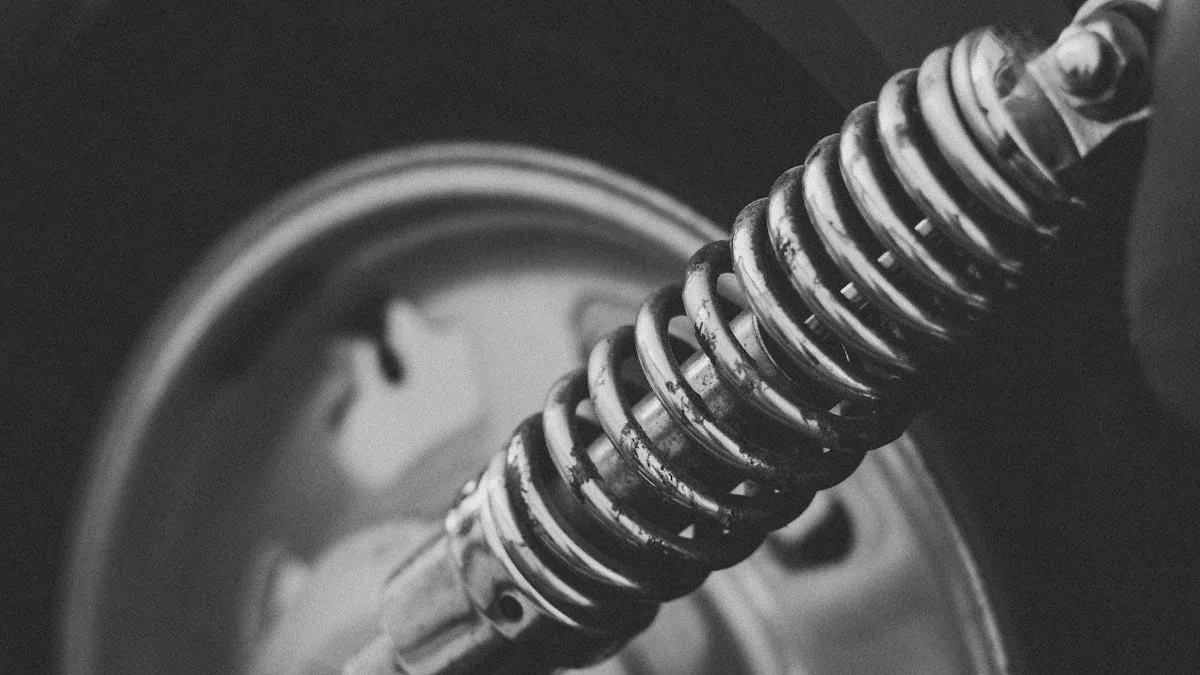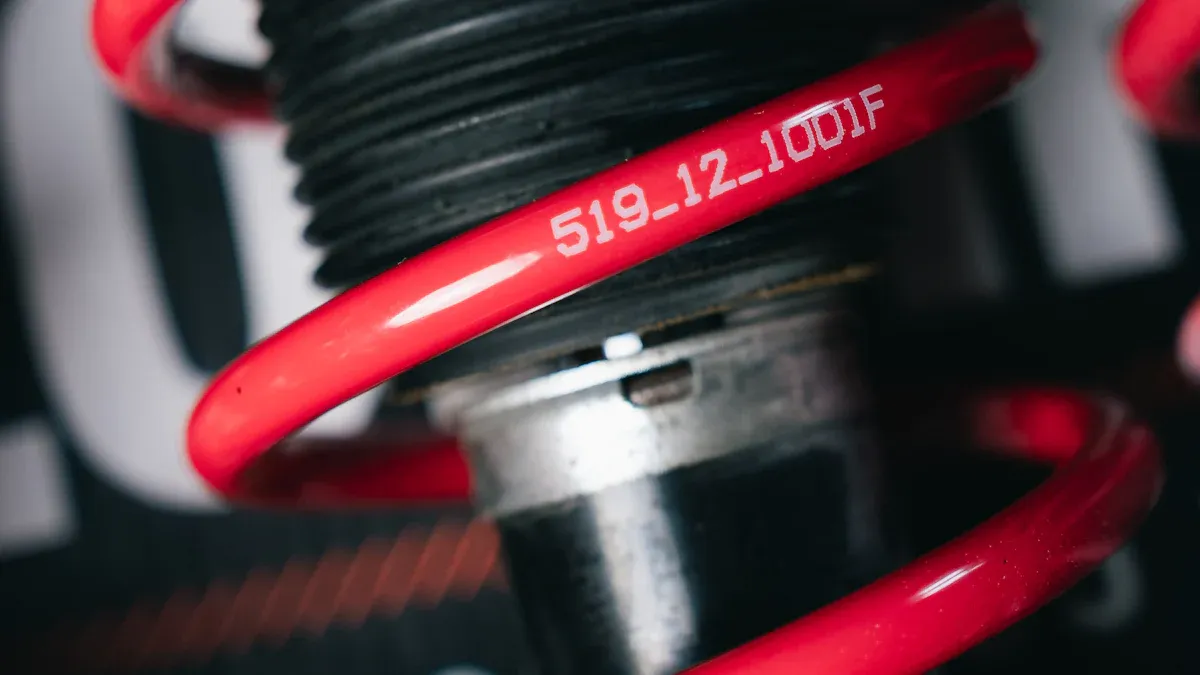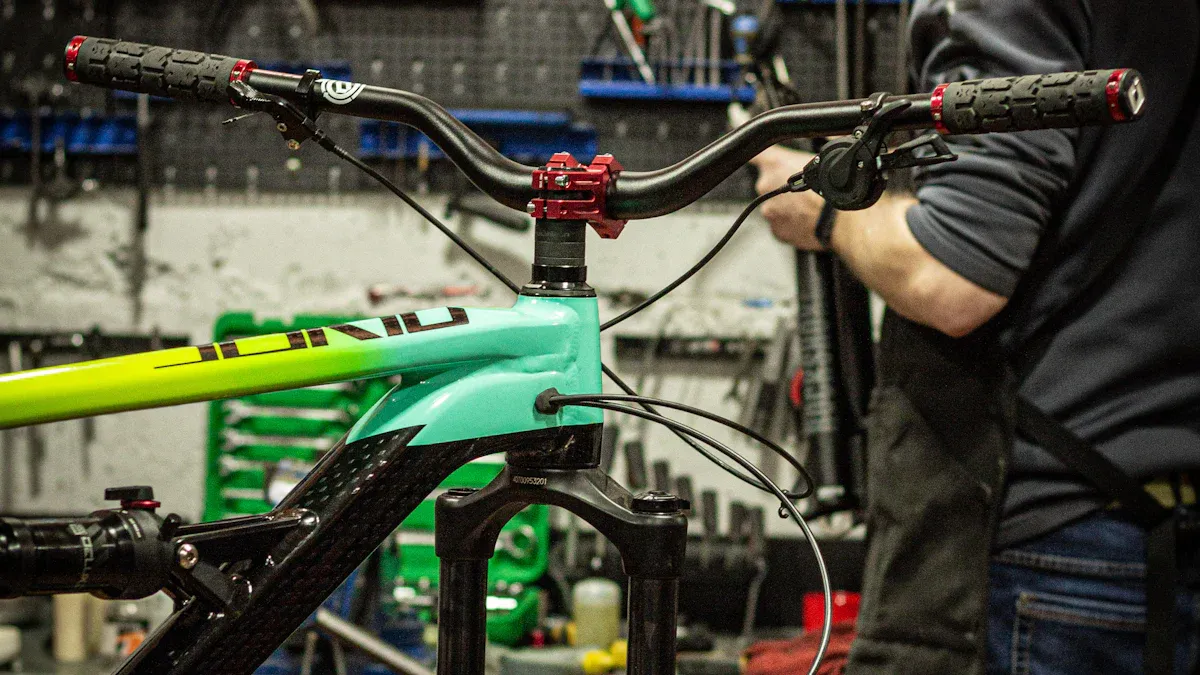
Your vehicle’s performance relies heavily on its suspension. With the market for aftermarket upgrades projected to grow significantly by 2028, drivers are increasingly seeking ways to optimize their ride. The key to this customization often lies within the shock absorber itself.
At the heart of this tuning are shock shims: thin, flexible metal discs that bend under pressure to precisely regulate oil flow. This action allows you to fine-tune how your suspension reacts to different speeds and impacts, enhancing both ride comfort and vehicle control. This precise regulation is the secret to unlocking your suspension’s true potential.
The Anatomy of a Shock Absorber’s Valving

To understand how you can tune your suspension, you first need to look inside the shock absorber. Whether you have a monotube design (a single shell case) or a twin-tube design (an inner and outer cylinder), the core components are similar. A piston moves through specialized oil, and this movement creates the damping force that controls your ride. The magic happens in the valving on that piston, which is where shim stacks come into play.
What is a Shim Stack?
A shim stack is a carefully arranged group of thin, spring-steel discs. These shock shims are placed over ports on the piston. The most common arrangement is a “pyramid stack,” where shims of the same thickness are stacked from the largest diameter at the bottom to the smallest at the top.
Think of it like a circular leaf spring. This pyramid shape helps distribute the force of the oil. It allows the shims to bend open and snap back without being permanently damaged, providing reliable and consistent performance.
This design creates progressive damping. During slow movements, oil pressure is low, and only the largest, most flexible shim bends slightly. During high-speed impacts, the pressure increases dramatically, forcing more of the smaller, stiffer shims in the stack to open. This gives you soft damping when you need comfort and firm damping when you need control.
Shim Damping vs. Orifice Damping
Suspension damping is all about controlling how quickly oil flows through the piston. There are two primary ways to do this:
- Orifice Damping: This is a simpler method where oil is forced through a fixed-size hole, or orifice. While it works, it has a major drawback. As piston speed increases, the resistance grows exponentially, which can make the ride feel harsh over fast, sharp bumps.
- Shim Damping: This is the modern, highly tunable method. Instead of a fixed hole, the piston ports are covered by the flexible shim stack. During the compression or rebound stroke, oil pressure pushes against the shims. The shims bend open, creating a variable-sized opening for the oil to pass through. This allows the shock absorber to react intelligently to the road, providing precisely the right amount of damping for any speed.
How Adjusting Shock Shims Changes Performance

You can transform your vehicle’s handling by making small, precise adjustments to the shim stack. The key is understanding how different properties of the shock shims and their arrangement directly influence your ride. By changing the thickness, diameter, and order of these discs, you gain direct control over the damping forces inside your shock absorber. This allows you to fine-tune your suspension for any condition.
The Role of Shim Thickness and Diameter
The physical dimensions of each shim are the most powerful tuning tools you have. Even a microscopic change can create a noticeable difference in your suspension’s behavior.
Thickness is the single most important factor. A thicker shim is much stiffer and harder to bend. The relationship between thickness and stiffness is exponential. In fact, a shim’s stiffness is a function of its thickness cubed (thickness x thickness x thickness). This means a tiny increase in thickness results in a massive increase in stiffness.
For example, look at how stiffness multiplies with just a fraction of a millimeter change:
| Original Shim Thickness | Equivalent Stiffness (in 0.1 mm Shims) |
|---|---|
| 0.11 mm | ~1.3 times stiffer |
| 0.20 mm | 8 times stiffer |
This stiffness directly translates to damping force, but not in a 1:1 ratio. Doubling the stiffness of a shim stack only increases the overall damping force by about 41%. This non-linear relationship shows how a shock absorber can handle a wide range of impacts.
Real-World Impact: Let’s see how adding a single shim changes performance. Adding a thin
0.20 mmshim to the low-speed part of the stack might increase damping force by a subtle 4%. However, adding a thicker0.30 mmshim to the high-speed stack can boost damping force by a significant 10-12%.
Diameter also plays a crucial role.
- Larger diameter shims are more flexible. They are placed at the bottom of the pyramid stack (closest to the piston) and control low-speed damping. They bend easily to absorb small road imperfections, giving you a smoother ride.
- Smaller diameter shims are stiffer. They sit at the top of the pyramid and primarily affect high-speed damping. They require much more force to bend, providing the firm control needed to prevent bottoming out on big hits.
The Function of Clamping and Crossover Shims
Beyond individual shim dimensions, the way you arrange the stack creates unique damping characteristics. Two special shims, the clamping shim and the crossover shim, are essential for this advanced tuning.
The Clamping Shim Think of the clamping shim as the foundation of your stack. It is the last shim in the sequence, and its diameter sets the pivot point for the entire stack. A smaller diameter clamping shim effectively shortens the “lever arm” of the other shims, making the whole stack feel stiffer. A larger clamping shim allows more of the stack to flex, making it feel softer.
The Crossover Shim This is where you can create a truly custom feel. A crossover shim is a smaller diameter shim placed between larger shims, creating a small gap. This gap allows the shock to have two different stages of damping.
How it Works:
- Stage 1 (Low-Speed): On small bumps, oil pressure is low. Only the large shims before the crossover gap bend. This creates a soft, comfortable response.
- Stage 2 (High-Speed): On a large, fast hit, oil pressure spikes. It quickly forces the initial shims across the gap, making them press against the stiffer crossover shim and the rest of the stack. This transition creates a firm damping force to control the impact.
By adjusting the crossover, you can precisely control your suspension’s personality.
- Diameter: A wider crossover shim allows the initial shims to bend more easily, softening the low-speed ride.
- Thickness: A thicker crossover shim creates a firmer “wall” for the initial shims to hit, increasing the high-speed damping rate.
- Position: Moving the crossover closer to the piston face reduces the initial stiffness, making the transition to high-speed damping happen sooner and at a lower force.
Tuning Damping for Specific Conditions
You can tune your shock absorber to handle specific situations by focusing on low-speed and high-speed damping. These two ranges control how your vehicle responds to different types of forces, from your own steering inputs to sudden impacts from the road.
Targeting Low-Speed Damping
Low-speed damping manages slow suspension movements. These movements typically happen at shaft speeds between zero and five inches per second. You create these inputs when you brake, accelerate, or steer through a corner. Adjusting low-speed damping is one of the most effective ways to change your car’s handling balance.
- Compression: To increase low-speed compression for better body control, you can use special ring shims. These shock shims preload the main stack, keeping it closed at lower oil pressures. This creates more resistance and firms up the initial suspension movement.
- Rebound: Adjusting low-speed rebound controls how quickly weight transfers across the vehicle. Stronger front rebound damping slows the rate of roll during cornering. This action can reduce the vertical load on the inside front tire, which is similar to using a stiffer anti-roll bar and can increase understeer. By tuning this, you gain precise control over how your suspension loads each tire during a turn.
Pro Tip: Fine-tuning low-speed damping gives you direct influence over vehicle characteristics like roll, pitch, and overall balance, making your car feel more responsive and predictable.
Targeting High-Speed Damping
High-speed damping deals with rapid suspension movements. These occur when you hit a large bump, a pothole, or experience a g-out on a track. The main goal here is to absorb large amounts of energy without losing control.
Insufficient high-speed compression damping is a direct cause of the suspension bottoming out. When your suspension runs out of travel, it can cause a sudden loss of traction and an uncomfortably harsh ride.
You can prevent this by increasing high-speed compression damping. This adjustment manages how the shock absorber behaves during very fast movements, like landing after a jump. It helps control the ride height of the suspension in these extreme moments. A properly tuned high-speed circuit allows your suspension to soak up big hits effectively, keeping the tires in contact with the ground and giving you maximum control when you need it most.
Practical Tuning Scenarios
Understanding the theory behind shock shims is the first step. Now, let’s apply that knowledge to solve common handling problems. By making targeted changes to your shim stacks, you can transform how your vehicle feels and performs on the road or trail.
Goal: Reducing Harshness Over Small Bumps
Does your vehicle feel jittery or harsh over cracked pavement, expansion joints, or washboard roads? This often means your low-speed and mid-speed compression damping is too firm. Your goal is to soften the initial suspension response so the tires can absorb these small imperfections without transferring the impact to you.
The most effective tool for this job is the crossover shim.
- The Problem: A standard pyramid stack can be too stiff for small, fast bumps, causing a harsh ride.
- The Solution: You can introduce a crossover shim into the compression stack. This smaller-diameter shim creates a gap between the initial, larger shims and the rest of the stiffer stack.
- The Result: On small bumps, oil pressure only needs to bend the flexible shims before the gap. This creates a soft, plush initial feel. This adjustment helps to reduce mid-speed damping, leading to a more consistent and predictable response as the shock moves through its stroke.
Advanced Tip: The Flutter Stack For high-performance off-road racing, tuners use a “Flutter Shim Stack.” This is an advanced application of the crossover concept. It uses a gap shim to create a larger soft zone, allowing the suspension to absorb rapid, low-force impacts (like on a washboard road) with incredible smoothness while still being ready to handle the next big hit.
Goal: Preventing Bottoming Out on Big Hits
Bottoming out occurs when your suspension runs out of travel on a large impact, like landing a jump or hitting a deep pothole. This creates a jarring bang and can cause a dangerous loss of traction. The solution is to increase your high-speed compression damping to better manage these intense forces.
You need to make your shim stack significantly stiffer deeper into the shock’s stroke.
- Add Thicker Shims: The most direct method is to increase the thickness of the shims in your high-speed stack. As mentioned, thicker shims are exponentially stiffer and require much more force to bend. Adding thicker face shims or increasing the stack’s overall stiffness makes the entire setup more resistant to high-velocity impacts.
- Adjust Stack Shape: A classic “big-to-small tree arrangement” is designed for this purpose. It creates a soft initial feel that progressively stiffens as more shims are engaged, providing a strong ramp-up in force specifically to prevent bottoming out.
- Change the Clamp: Using a smaller diameter clamping shim will pre-stress the stack, making the entire assembly stiffer and more resistant to high-speed forces.
For extreme applications, even more aggressive solutions are available. Some race vehicles use a Rate Plate, which is an extra-thick, non-flexible shim that acts as a firm stop, creating a sudden and dramatic increase in damping force.
Goal: Improving Control During Braking and Cornering
If your vehicle feels unstable during driver inputs—like the nose diving under braking or the body rolling excessively in turns—you need to adjust your low-speed damping. These settings control how the vehicle’s weight shifts, directly impacting its balance and responsiveness.
To Reduce Nose-Dive During Braking: The forward lurch you feel during heavy braking is caused by weight transferring to the front wheels. You can manage this by making a specific adjustment.
Increasing the low-speed compression damping in your front shocks is the key. This change adds resistance to slow suspension movements, limiting how quickly weight can transfer forward. This keeps the vehicle more level and stable, giving you greater confidence and control under heavy braking.
To Reduce Body Roll During Cornering: Controlling body roll is about managing how quickly the chassis can lean. While anti-roll bars play a big role, you can fine-tune this with your shocks.
- Increase Low-Speed Rebound: Stiffening the low-speed rebound damping on the front shocks slows the rate at which the inside wheel extends and the outside wheel compresses. This action helps keep the car flatter through turns.
- Balance is Key: By carefully adjusting low-speed compression and rebound, you can fine-tune your vehicle’s handling characteristics, such as understeer and oversteer. This allows you to dial in a predictable and responsive feel that perfectly matches your driving style.
Shock shims are the essential parts for customizing your suspension. You gain precise control over your suspension by adjusting the thickness, diameter, and arrangement of these discs. This allows you to transform a generic suspension setup into one perfectly optimized for your vehicle. Drivers who tune their suspension often report positive results:
- The right shim kit simplifies the entire tuning process.
- Many drivers see better lap times on the track.
With expert support, you can achieve professional-level tuning. This will unlock your vehicle’s true suspension performance potential.
FAQ
Can you tune your own shock shims?
Yes, you can tune your own shocks with the right tools and a clean workspace. The process requires careful disassembly and reassembly of the shock absorber. Following proper safety procedures is essential for a successful adjustment.
What is the difference between compression and rebound damping?
Compression damping controls the force as your suspension shortens over a bump. Rebound damping controls the speed at which your suspension extends back out. You tune both separately to manage your vehicle’s handling and ride quality.
How do you know which shims to change?
First, identify a specific handling issue. To fix harshness on small bumps, you adjust the low-speed shims. To prevent bottoming out on big hits, you change the high-speed shims. Always make small, single changes to test the effect.
Is shim tuning only for professional racers?
Absolutely not! 🛠️ While racers use it for lap times, you can tune your suspension for any goal. This includes improving off-road capability, creating a smoother daily ride, or achieving better control while towing a heavy load.
